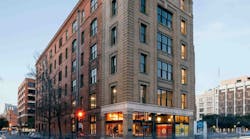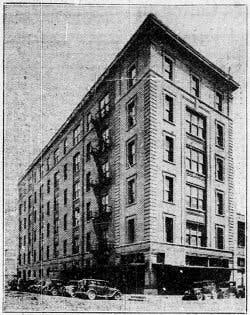Meet the Historic Building at the Center of Dallas’ West End Revival
Ten years ago, downtown Dallas was essentially a ghost town after 5 p.m. Like many urban destinations around the country, however, the city is experiencing a revival—particularly in its West End Historic District.
“It’s a thriving urban environment with people living, working and playing here,” said Tanya Ragan, president of real estate management, development and investment company Wildcat Management. “Creatives and young people want to be in wide open spaces with high ceilings and exposed brick. They want that authenticity that we’ve lost in a lot of these old buildings because we’ve tried to make them look new.”
Thanks to Ragan’s purchase of the Purse Building in 2014 and its subsequent renovation, one of the city’s iconic architectural structures is now an open and airy creative office space for the country’s top innovators.
Built in 1905, the 65,000-square-foot building—listed on the National Register of Historic Places and protected as a Texas State Archeological Landmark—was originally named the Parlin and Orendoff Building, but eventually adopted its moniker after longtime tenant Purse & Co. Wholesale Furniture. The building was also a temporary FBI operations center following the JFK assassination in 1963 due to its proximity to Dealey Plaza, as well as home to county offices before it sat vacant for nearly 30 years.
Ragan, the only female commercial real estate developer in downtown Dallas, is the fourth owner in the last decade—and the first female owner of the Purse Building in its storied, 116-year history.
“What’s so special about the Purse Building is, the city has had a romance with that building,” Ragan said. “It is a building that sits right on our one of our busiest streets, Elm Street, in the center of our urban core. It’s just adjacent to our historic county courthouse, Old Red, and it’s the entryway to this historic neighborhood, the Dallas West End.”
Uncovering Beauty Beneath Neglect
Preserving the integrity of the Chicago Italianate style building required Ragan and local architecture firm Architexas to adhere to strict standards regarding original materials and design elements, paint colors and types of new materials that are considered appropriate, limits on the maximum height for district buildings, and the types and number of signs allowed on any given facade. The renovation of the building’s exterior and interior revealed its stunning character as the process uncovered, layer by layer, the beauty of what lies beneath the patina of neglect.
“The first phase [of the renovation] was just finding out what we’ve got, what we what we were dealing with,” Ragan recalled. “We came in, we did all of the environmental assessments, all the abatement, we demoed, we took everything back to shell and […] we were very excited to find that when we started pulling all the layers, we found the original, 100-plus-year-old pine timber floors, all of the exposed brick, heavy timber columns and beams, and floor-to-ceiling windows.”
[Related: Historic San Francisco Building Blends Past and Present with a Modern Addition]
Ragan said the building’s restoration was inspired by the work of author, urbanist and activist Jane Jacobs, whose larger-than-life face is printed in the building’s ground floor showroom along with her quotation, “New ideas need old buildings.”
“I’m a huge fan of Jane Jacobs,” Ragan said. “I’m very inspired by her story. I relate a lot to her mission, and her approach. And I think that with this neighborhood in particular, we’ve been able to keep the diversification, we’ve been able to keep the original neighborhood fabric and we’ve been able to adapt these buildings to new technology uses that I feel really falls in line with what her mission was.”
The Purse Building is now leasing with the goal of attracting an anchor tenant—one that fits within a 30,000- to 65,000-square-foot floor plate that can capitalize on its high visibility in the central business district and bustling Elm Street.
“We’re bringing a product to the market that gives the people of Dallas the best of both worlds—preservation of our city’s history with all the most desirable features of modern commercial real estate,” Ragan said.
The city has taken note. The project was named a finalist for the Dallas Business Journal’s Best Real Estate Deal of 2019 for the Rehab/Re-Use category.
The Purse Building’s restoration has reversed years of accumulated neglect, taking the historic building back to her glory and positioning this “grand dame of a building” at the center of the Dallas West End revival.
Read next: How the Space Needle’s New Observation Deck Celebrates Its Original Design:






